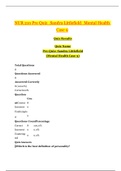Conor Cunningham P1
C
The following is the cost of production of water bottles which Sophie plans to produce this
financial year. This will be calculated using the absorption costing method. Absorption costs
are the total costs involved which include fixed costs and variable costs.
Absorption costing = FC + VC
= £113,760 + £111,240
= £225,000
Number of units = 1,500,000
Cost per unit = 225,000
1,500,000
= 15p per bottle
Mark-up = 70%
Selling price = 15p x70%
15p + (15 x 70%)
15p + 10p
Selling price = 25p per unit
D
Marginal costing = VC + SVC
= 111,240 + 0
1,500,000
= 7p per unit (500ml bottle water)
E
The marginal cost of an item is its variable cost. The marginal production cost of an item is
the sum of its direct materials cost, direct labour cost, direct expenses cost (if any) and
variable production overhead cost. So as the volume of production and sales increases total
variable costs rise proportionately.
Fixed costs, in contrast are cost that remain unchanged in a time period, regardless of the
volume of production and sale.
Marginal production cost is the part of the cost of one unit of production service which
would be avoided if that unit were not produced, or which would increase if one extra unit
were produced. From this we can develop the following definition of marginal costing as
used in management accounting;






